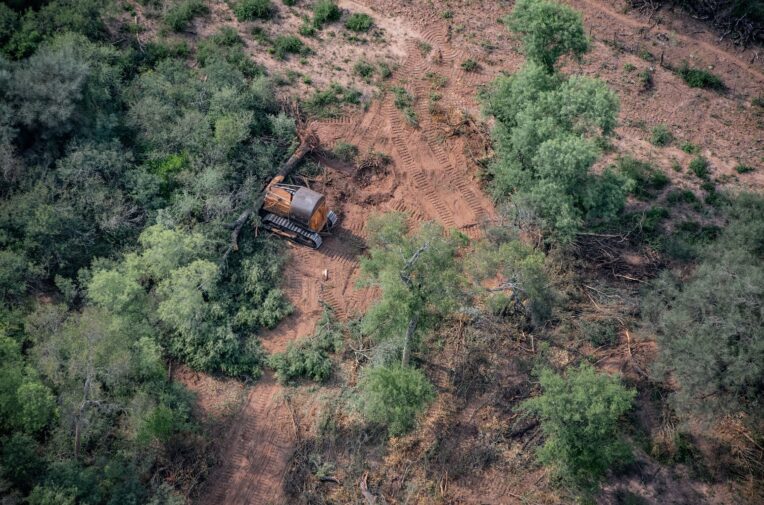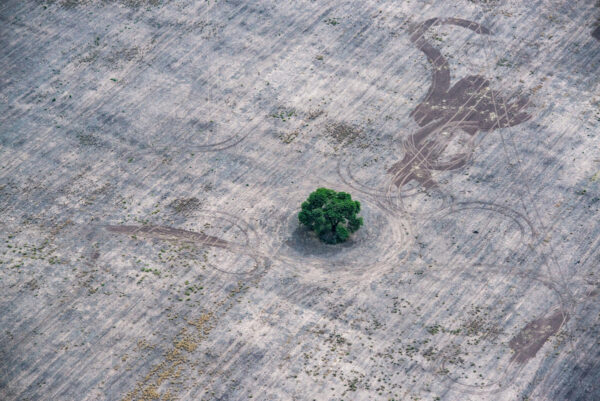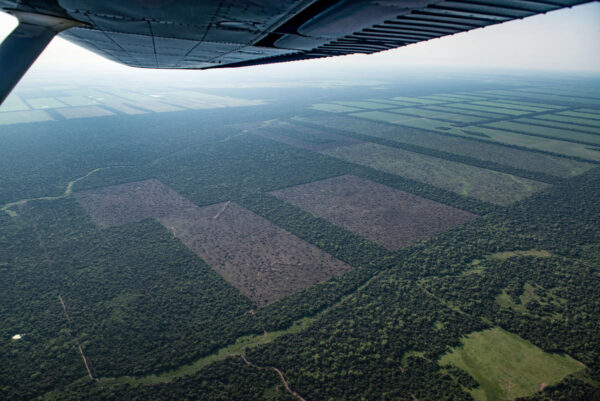
The Gran Chaco is the second largest forest in South America, after the Amazon. Photo: Martin Katz/Greenpeace
Deforestation and land-grabs bring Covid-19 threats to Amazon and Gran Chaco residents
Indigenous leaders and NGOs from South America’s two largest forests have reported rising illegal deforestation and violence during the pandemic, with little government aid or oversight
Deforestation and land-grabs bring Covid-19 threats to Amazon and Gran Chaco residents
Indigenous leaders and NGOs from South America’s two largest forests have reported rising illegal deforestation and violence during the pandemic, with little government aid or oversight
The Gran Chaco is the second largest forest in South America, after the Amazon. Photo: Martin Katz/Greenpeace
“As I am standing here at this corner, talking to you on the phone, I have seen three bulldozers drive by.”
For Deolinda Carrizo, an Indigenous leader from the Santiago del Estero province in Argentina, the emergence of Covid-19 has been a battle on two fronts. First, defending her community’s land against ongoing, increasingly frequent deforestation. And second, doing so in the middle of a global pandemic, facing an increased risk of Covid-19 transmission brought into the community by the deforesting teams on those very bulldozers.
“They come in and out of the fields and bring teams with many people – each vehicle has at least ten people,” Carrizo told Unearthed.
“At a distance, I see two more bulldozers, with a lot of people on top. When it’s time to transport the grain crops, there is an insane number of people around. Dozens, scores, hundreds of outsiders, everywhere you go.”
Carrizo is a peasant farmer from the Vilela community, and her town is located in the Gran Chaco, South America’s second-largest forest, which spans northern Argentina, Paraguay, Bolivia and Brazil.
Unearthed has spoken to Indigenous leaders from the Gran Chaco and the Amazon who report increased violence against land defenders ever since the virus emerged and lockdowns began. The situation has often left land defenders vulnerable and isolated, with little access to support from the NGOs and government oversight bodies that normally serve to prevent or document this violence. This lack of oversight has also accelerated rates of illegal deforestation – our sources say – a trend evident in satellite data on forest loss in Argentina, Paraguay, Colombia and Brazil.
But these are not the only threats they face. Indigenous rights defenders fear the people conducting this deforestation have also become vectors for Covid-19 transmission, repeatedly travelling between urban centres with high infection rates and more isolated rural areas, and often violently clashing with Indigenous and peasant farmer communities defending their territory.
It is a situation which forces communities into a grim choice: protect their forest and way of life or stay away and safer from the pandemic.
Argentina is currently among the top ten countries in the world for the number of confirmed Covid-19 cases – and the numbers have been rising to new heights since July.
“When the government said we have to stay at home and keep safe, and the lockdown started, deforestation didn’t stop,” one source, a biologist and resident of the Chaco province, told Unearthed.
“We lost so much forest during the lockdown.” The source asked not to be named because of fears for her safety.
Greenpeace’s satellite monitoring in the Argentinian Gran Chaco found that there was a 2,500 hectare increase in land deforested between January and June 2020 and the same period in 2019. In particular, between March and May of this year, when the country was under complete lockdown, the rate of deforestation was 80% higher than the same time last year.
Multiple sources and datasets paint a similar picture across other parts of the Chaco and Amazon regions. Data collected by Global Landscape Analysis and Discovery (GLAD) and the WWF found that deforestation has rapidly increased since lockdown began, not only in South America but across Asia and Africa as well.
“We’ve heard of communities at El Sauzalito in the Chaco province where they were in lockdown – because the virus was there – and when they went [back] to the forests, they found that the trees were robbed. They had been extracted,” our source described.
Deforestation by burning or bulldozing trees clears the land for cattle, soy, corn and other grain farming; while it is usually permitted in specific parts of Argentina, it was illegal during the lockdown. But the law is weak when there is nobody there to enforce it. Even before lockdown, illegal deforestation was rife, displacing those who live in the forest and reducing their access to traditional farming methods, cultural practices and ancestral territory.
“[Contracted armed forces] displace these local communities to other areas, peri-urban areas. They have to leave their lands, their homes, they’re forced to leave violently,” our source said.
“[The forces] come with guns, they come with people who are paid to kill if [the residents] won’t leave.”
Private armed contractors are often hired by landowners or others looking to extract resources from the region.

Carrizo told Unearthed that multiple communities, including her own, have managed to successfully defend their territory against deforestation. But some have paid the price: house arrest, police detention, or accusations of “attacking” the deforesting teams they were resisting.
“The main changes resulting from COVID-19 in our communities are in how we used to be organised, how we shared information, the ways in which we responded to attempts of intimidation and the trampling of our rights by the authorities. Before, we could always respond to calls from our members – now our response is limited. The agro-business is taking advantage of this situation.”
The companies do whatever they want…They are more concerned about their cattle industry than the pandemic
Carrizo’s experiences echo those of land defenders across the Gran Chaco and Amazon, where the pandemic has jeopardised land rights and the well-being of Indigenous communities.
Across Argentina’s northeastern border, the Paraguayan Chaco saw massive deforestation this year starting in January itself, according to data provided to Unearthed by biodiversity conservation organisation Guyra Paraguay. Similar to the trends in Argentina, Guyra’s satellite data on forest loss shows a 2,000 hectare increase in deforestation between the first six months of 2020 and the same period in 2019. While there was a significant decrease in deforestation between March and April, a Guyra spokesperson noted their figures could increase as new information comes to light through the year.
Paraguay has one of the highest rates of deforestation in the world, and it takes place primarily to convert forest land into cattle pasture. According to data from Trase, a supply chain tracker, 703,000 hectares of deforested land have been turned to cattle pasture in the last four years alone – that’s an area four times the size of London.
Aquino Picanerai, an Indigenous Ayoreo leader from the Paraguayan Gran Chaco, told Unearthed that deforestation has continued without any community consultation during the pandemic.
“The companies do whatever they want,” Picanerai said. “The people who come to clear the forest don’t care about spreading the COVID-19 virus, they are more concerned about their cattle industry than the pandemic.”
During the lockdown, some Ayoreo people lost their jobs, and food and water became scarce in certain towns and villages. These conditions, Picanerai said, make the risk of Covid-19 transmission even more dire – and while the number of cases in the country are significantly less than other parts of South America, the rate has been rising since August.
“There is no preparation to deal with COVID-19, no hospital to deal with sick people. If [community members] get infected, I am sure there will not be medication for them.”
In the neighbouring Bolivian Chaco, a representative of Nativa – an organisation that monitors deforestation and land rights in the country – told Unearthed that while they also don’t have figures for the rate of deforestation yet, they are concerned about the spread of the virus.
“The coordinator for the Defense of Indigenous, Native, Peasant and Protected Areas has highlighted the alarming situation of 46 indigenous territories that faced more than 1,101 cases of Covid-19 infections […]. Several Indigenous organisations attribute the cause of the contagion to companies that operate in their environment.”
‘A human rights crisis and a humanitarian emergency’
Brazil’s deforestation crisis during the pandemic has been widely reported on, including by Unearthed, as rates of deforestation rose to new heights during the lockdown. In the first four months of the year, deforestation rates were 55% higher than the same period last year and continued upwards since. Unearthed also found that fires in the Amazon and other areas of Brazil have reached record highs this fire season.
In the Colombian Amazon, the SINCHI Institute – an Amazonian research body run by the Colombian government – has recorded three times as many heat points between March and September of this year than the same period in 2019. Heat points are sites of forest-burning, a common form of deforestation; while some forest fires may also be included in the count, the satellite monitoring of heat points is understood to be a reliable way to monitor deforestation.
March 2020 saw a massive spike, with more than 13,000 heat points in the month alone compared to 1,300 in March 2019. The rate then dipped significantly in April, but again rose between May and September 2020 to more than double the same time last year.
While the UK researchers studying the impact of Covid-19 on deforestation in the Colombian Amazon can’t say for certain what caused the March spike, they attribute it to reduced government supervision, preparation in anticipation of an extended lockdown, the “mobilization of armed groups”, or a late dry season in the country. The SINCHI Institute declined to comment on the spike.
But the pattern is global: March saw a worldwide increase in deforestation, with rates reaching 150% of the 2017-19 averages for the same month. While researchers are still collating deforestation rates from the latter half of the summer to determine the extent of the crisis, there is little evidence that the rates have been brought back under control since lockdowns began across South America.
“Deforestation has increased, and it is possible that it will increase even more,” Luz Mery Panche Chocue, an Indigenous woman from the Nasa ethnic group in Colombia, told Unearthed.
She added: “Attacks against organised defenders of the territory have increased. With the lockdown, we were all supposed to stay put in our homes, away from the risk of contagion; confinement was supposed to guarantee at least a respite of protection to our health, but the operations have continued.”
Colombia is sixth in the world for Covid-19 cases, with more than 700,000 confirmed as of mid-September. The country went through five months of lockdown, from March 20 until the end of August.

This confinement period may have exacerbated the violence: land defenders often remain isolated within their homes, where armed forces can track them down and threaten, injure or kill them more easily. The conditions of the pandemic also mean land defenders’ allies have continually struggled to move around the region and communicate with communities who have no phone or internet access.
This year, there have already been at least 95 murders of human rights defenders in Colombia, according to Somos Defensores, a Colombian NGO dedicated to recording rates of violence against human rights defenders in the country. That’s a 61% increase from the same time period last year.
Sirley Yesenia Muñoz Murillo, the Communications, Advocacy and Information Coordinator for Somos Defensores, told Unearthed that she fears the full extent of the violence is even greater – she just doesn’t know by how much, yet.
Her organisation hasn’t been able to travel to Indigenous territories for fieldwork both because mobility has been restricted by government regulation throughout the lockdown, and because travel might risk introducing the virus to remote communities. As of June, Colombia had the third-highest rate of Covid-19 infection among Indigenous people, with 1,809 recorded cases.
We have exhausted all the options of resorting to the authorities.
So far, Somos Defensores has only travelled out to the territories twice this year. As a result, they aren’t able to gather information about all the murders, injuries, threats, and other forms of violence that have taken place since March. The same limitations have prevented land defenders from seeking help from government oversight bodies.
“Most [defenders] are in rural areas really far from the cities, and […] the government and the state are not present, are completely absent,” Murillo told Unearthed. “And these territories where the state is absent, a lot of armed groups are there at the moment.”
The armed groups Murillo is referring to are contracted mainly by three sources in Colombia: multinational companies interested in resource extraction, political paramilitary forces, and narco-traffickers.
In 2019, international non-profit the Business and Human Rights Resource Centre released a report stating that 90% of the attacks against human rights defenders in Colombia took place against defenders fighting resource extraction projects, including mining, fossil fuels, agriculture and hydroelectric energy.
Murillo describes contracted armed forces as being the convenient option for economic and political actors in Colombia “because then they don’t take any responsibility for the [violence]”.
“It’s really important to emphasise the responsibility of the state, because they have not been doing the right job in providing security for rights defenders,” she said. “In theory, [land] defenders can go and seek help with the organisations of the state – the Ministry of Interior or Ombudsman. But the Ministry of the Interior is unresponsive to requests for help, and mobility and connectivity limitations mean many people in need of help can’t reach the ombudsman’s office.”
‘We have exhausted all the options’
Murillo fears international NGOs will withdraw their support from human rights defenders in the Colombian Amazon, misunderstanding incomplete data about violence against defenders as a decrease in rates of violence during the pandemic.
“The risk is that this is going to appear in the eyes of the international community and the government as a decrease in the amount of violence and threats against the defenders,” Murillo said. “The reality is the opposite, because [the violence] is actually increasing.”
Losing the attention of the international community could mean losing funding, less pressure on the Colombian government and less accountability for the violent or exploitative groups on the ground.
With companies risking the lives of Indigenous and peasant farmers with such impunity, Picanerai and the other Indigenous leaders with whom Unearthed spoke believe the solution lies with international support.
“We have exhausted all the options of resorting to the authorities. The only thing left to do is to have the United Nations, or other organisations who advocate for human rights, to intervene and tackle deforestation,” Picanerai said. “I think that if the United Nations pressure the Paraguayan government and the authorities into compliance with environmental protections and respect for indigenous communities, our claims could be heard.”
For Chocue, beyond international pressure, the situation demands a return to Indigenous self-determination.
“We have been excluded from all the spaces of participation, and now we say it is time to go back to the origins and to take part in planning the future of the region, the country, and the planet.”

